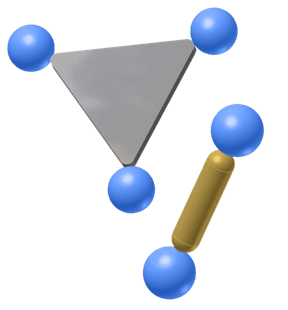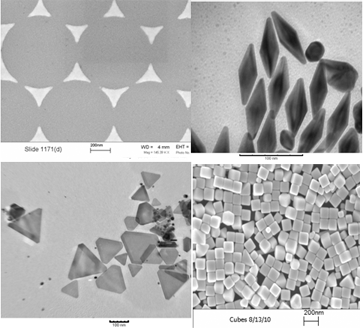Members: Stefan Stoianov, Jason Ridley, Erich See |
|
|
|
 |
Colloidal "molecules" of this kind could find applications in fields such as nanomedicine, chemical sensing,nano optics, and microelectronics. They are also interesting from a fundamental perspective, as assemblies combining well-defined magnetic, optical, mechanical, chemical, and other properties can be combined in new ways leading to new states of matter displaying new and unexpected phenomena. |
When metal nanoparticles are illuminated with light that is resonant with their plasmonic resonances, the light is concentrated into nanometer sized areas, known as "hotspots", located at sharp corners or narrow gaps on and between the particles. The electromagnetic intensity at the hotspots can be 104 times or more the incident intensity. This means that photoactivated chemical reactions are much more likely to take place at the particle hotspots than anywhere else, making it possible to modify the surface chemistry of the particles in a selective way, creating what is known as a patchy particle. The patchiness can then be used to guide the assembly of well-defined molecule-like structures. This principle behind is illustrated in the cartoon below. In this example, gold nanorods are functionalized with a compound that has the property that when absorbing an ultraviolet photon (wavelength ~ 360 nm), a piece cleaves off, revealing a primary amine to which other compounds can then be coupled. The compound can also be cleaved by two-photon absorption near 720 nm, so the gold nanorod is designed to have its plasmon resonance located at that wavelength. This nonlinear process scales in efficiency with the electromagnetic intensity, so the selectivity for photocleavage at the hotspots will be the intensity enhancement squared, or as high as 108. Therefore, when the rods are illuminated with pulsed light from an ultra-fast laser at 720 nm wavelength, amines will be revealed virtually exculsively at the ends to the rods, where the hotspots are located. The amines can then be coupled to a crosslinker such as NHS-PEG4-biotin, resulting in rods funcionalized at the ends with biotin. Biotin binds with great specificity to the protein streptavidin, so if nanospheres functionalized with that protein are added, dumbbell shaped colloidal molecules will assemble spontaneously.
|
|
 Over the past ten years, nanoscience has developped to the point where particles of a variety of well-defined shapes can be synthesized in large numbers without using lithographic methods. The illustration on the right shows just a few examples that we are fabricating in our lab. The next great challenge in this area is assemble these building blocks into larger ordered structures. This purpose of this project is to develop a method for accomplishing this using plasmonic resonances in metal nanoparticles as a means to affecting the assembly. This will lead to well-defined colloidal assemblies such as those depicted below.
Over the past ten years, nanoscience has developped to the point where particles of a variety of well-defined shapes can be synthesized in large numbers without using lithographic methods. The illustration on the right shows just a few examples that we are fabricating in our lab. The next great challenge in this area is assemble these building blocks into larger ordered structures. This purpose of this project is to develop a method for accomplishing this using plasmonic resonances in metal nanoparticles as a means to affecting the assembly. This will lead to well-defined colloidal assemblies such as those depicted below. 